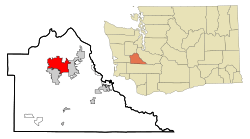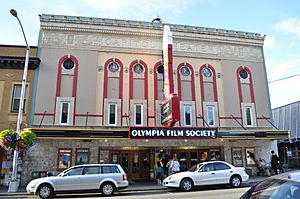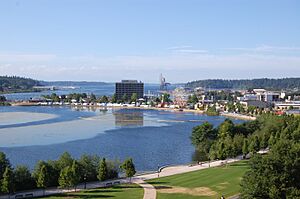Olympia, Washington facts for kids
Quick facts for kids
Olympia, Washington
|
|||||
|---|---|---|---|---|---|

From top, and left to right: Old Capitol Building, East Olympia, Interstate 5 at the junction of U.S. Route 101, Port of Olympia, Downtown from Capitol Lake, Washington State Capitol, Salmon sculpture, Mount Rainier, Percival Landing Park, Olympic Mountains and Swantown Marina
|
|||||
|
|||||
| Nickname(s):
Oly
|
|||||

Location within Thurston County in Washington
|
|||||
| Country | United States | ||||
| State | Washington | ||||
| County | Thurston | ||||
| Incorporated | January 28, 1859 | ||||
| Named for | Olympic Mountains | ||||
| Government | |||||
| • Type | Council/City Manager | ||||
| Area | |||||
| • City | 20.09 sq mi (52.02 km2) | ||||
| • Land | 18.23 sq mi (47.20 km2) | ||||
| • Water | 1.87 sq mi (4.82 km2) | ||||
| Elevation | 95 ft (29 m) | ||||
| Population
(2020)
|
|||||
| • City | 55,605 | ||||
| • Estimate
(2023)
|
55,733 | ||||
| • Rank | US: 718th WA: 24th |
||||
| • Density | 2,902.26/sq mi (1,120.58/km2) | ||||
| • Urban | 208,157 (US: 182nd) | ||||
| • Urban density | 1,960.0/sq mi (756.8/km2) | ||||
| • Metro | 298,758 (US: 172nd) | ||||
| Demonym(s) | Olympian | ||||
| Time zone | UTC-8 (Pacific (PST)) | ||||
| • Summer (DST) | UTC-7 (PDT) | ||||
| ZIP codes |
98501–98509, 98511–98513, 98516, 98599
|
||||
| Area code | 360, 564 | ||||
| FIPS code | 53-51300 | ||||
| GNIS feature ID | 1533353 | ||||
Olympia is the capital city of Washington, a state in the United States. It is also the main city of Thurston County. In 2020, about 55,605 people lived there. This makes it the 23rd largest city in Washington. Olympia is next to Lacey on its east side and Tumwater to its south.
Long before European and American settlers arrived, the Squaxin and other Coast Salish peoples lived in the southern Puget Sound area. Important agreements, like the Treaty of Medicine Creek in 1854 and the Treaty of Olympia in 1856, were signed. These treaties led to the Squaxin people moving to Indian reservations. Olympia officially became a town on January 28, 1859, and later a city in 1882.
Contents
History of Olympia
The land where Olympia now stands was home to the Steh-Chass people for thousands of years. These people spoke the Lushootseed language. Other Native American groups, like the Nisqually and Puyallup, also visited the area often.
The first Europeans came to Olympia in 1792. Peter Puget and his crew from a British expedition explored the area. However, they did not write about meeting the Native people living there. In 1846, Edmund Sylvester and Levi Lathrop Smith claimed the land that is now downtown Olympia.
In 1851, the U.S. government made Olympia the home for the customs house of Washington Territory. More people moved to the area, many coming from the Oregon Trail. In 1850, the town was named Olympia. This name was suggested by Colonel Isaac N. Ebey because of the beautiful view of the Olympic Mountains. Small steamboats, known as the Puget Sound Mosquito Fleet, began serving the area.
Treaties and Conflicts
From December 24 to 26, 1854, Governor Isaac I. Stevens signed the Treaty of Medicine Creek. This treaty was with representatives from several Native American tribes. It said that Native Americans could still fish, hunt, and gather. However, it also said that they had to move to one of three reservations. This meant the Nisqually people would lose their good farming and living areas.
Another agreement, the Treaty of Olympia (also called the Quinault Treaty), was made in 1855. Chief Leschi, a Nisqually leader, was very upset. He refused to give up his people's land. He fought for their rights, which started the Puget Sound War. The war ended when Leschi was captured in 1856. He was executed two years later.
Modern Development
The 1949 Olympia earthquake caused a lot of damage. Many old buildings were so broken they had to be torn down. Earthquakes in 1965 and 2001 also damaged parts of the city.
Interstate 5, a major highway, was built through the south side of Olympia in the late 1950s. It was meant to replace older roads that went through downtown. The freeway opened on December 12, 1958, and was made bigger in 1991.
Geography and Climate
Olympia is in Thurston County, at the southern end of Puget Sound. It sits on Budd Inlet, where the Deschutes River meets the Sound. In 1951, a dam was built on the river to create Capitol Lake. The state government plans to remove this dam to bring back the natural river mouth.
The city is about 47 miles (76 km) southwest of Seattle. It is also about 100 miles (160 km) north of Portland, Oregon. Olympia covers an area of about 19.68 square miles (50.97 km²). Most of this is land, with some water. Lacey and Tumwater are cities that border Olympia.
Much of downtown Olympia was built on reclaimed land. This means land that was once underwater or marshy was filled in. This started in the 1870s, but a big change happened in 1910–11. Over 2 million cubic yards of dirt were used to fill in tidal areas. This created almost 30 blocks of downtown Olympia and made a deep-water port.
Olympia's Climate
Olympia has a warm-summer Mediterranean climate. This means it has dry summers, especially in July. Early June and late August can be a bit humid. July and August nights are cool. Most of western Washington's weather comes from systems near the Aleutian Islands in Alaska. These bring cold, moist air, causing rain, clouds, and fog.
November through January are the rainiest months in Olympia. Streets, creeks, and rivers can flood from November to February. The average temperature ranges from 38.4°F (3.6°C) in December to 64.1°F (17.8°C) in August. Olympia gets about 50 inches (1,270 mm) of rain each year. It is cloudy about 75% of the time.
The coldest temperature ever recorded was -8°F (-22°C) on January 1, 1979. The hottest was 110°F (43°C) on June 28, 2021. On average, the temperature reaches 90°F (32°C) about 6.3 days a year. It stays at or below freezing all day about 1.8 days a year.
Artesian Water
Olympia has always relied on artesian water. These are natural springs where water flows up from underground. An important artesian spring was at Fourth Avenue and Main Street (now Capitol Way). Early settlers and Native Americans would gather there.
Today, an artesian well is active at Artesian Commons park. Another still flows at Olympia Avenue and Washington Street. There's also a small park built around a spring in the Bigelow Neighborhood. The main water source for Olympia, McAllister Springs, also comes from artesian wells. The old Olympia Brewery used water from 26 artesian wells.
People have worked to protect these free-flowing wells since 1991. Groups like "Friends of the Artesians" and H2Olympia have helped. In 2011, the city of Olympia spent $50,000 to improve a well in a parking lot. They added solar lighting and a raised area for filling bottles. In 2012, sea-themed artwork made by the community was added to the well site.
Population and People
| Historical population | |||
|---|---|---|---|
| Census | Pop. | %± | |
| 1870 | 1,203 | — | |
| 1880 | 1,232 | 2.4% | |
| 1890 | 4,698 | 281.3% | |
| 1900 | 3,863 | −17.8% | |
| 1910 | 6,996 | 81.1% | |
| 1920 | 7,795 | 11.4% | |
| 1930 | 11,733 | 50.5% | |
| 1940 | 13,254 | 13.0% | |
| 1950 | 15,819 | 19.4% | |
| 1960 | 18,273 | 15.5% | |
| 1970 | 23,296 | 27.5% | |
| 1980 | 27,447 | 17.8% | |
| 1990 | 33,840 | 23.3% | |
| 2000 | 42,514 | 25.6% | |
| 2010 | 46,478 | 9.3% | |
| 2020 | 55,605 | 19.6% | |
| 2023 (est.) | 55,733 | 19.9% | |
| U.S. Decennial Census 2020 Census |
|||
2020 Census Information
In 2020, Olympia had 55,605 people. The city had about 2,825 people per square mile (1,091 per km²). There were 25,642 homes.
The people living in Olympia were:
- 78.4% White
- 9.6% Hispanic or Latino
- 7.3% Asian
- 3.1% African American
- 6.9% from other races or mixed races
2010 Census Information
In 2010, Olympia had 46,478 people. There were 20,761 households, and 10,672 families. The average number of people in a household was 2.18, and the average family size was 2.83.
About 19.5% of residents were under 18 years old. 11.2% were between 18 and 24. 28.5% were between 25 and 44. 26.7% were between 45 and 64. And 13.9% were 65 years or older. The city had 47.3% males and 52.7% females.
Economy and Jobs
Olympia has many different types of jobs. The biggest employer in the area is the State of Washington, including its education system. This provides jobs for over 20,000 people. Local government and education also employ many people.
Here are some of the top employers in Olympia:
| Rank | Employer | Number of employees |
|---|---|---|
| 1 | State of Washington, including education | 20,566 |
| 2 | Local government, including education | 2,593 |
| 3 | Providence St. Peter Hospital | 2,173 |
| 4 | Capital Medical Center | 700 |
| 5 | YMCA | 700 |
| 6 | Washington State Employees Credit Union | 501 |
| 7 | AMR Corp | 499 |
| 8 | Titus Will | 431 |
| 9 | Olympian | 366 |
| 10 | Olympia Orthopedic | 300 |
Arts and Culture
Olympia is a hub for fine arts in its region. You can find many theatrical shows from groups like Animal Fire Theater and Olympia Family Theater. The Olympia Symphony Orchestra performs concerts at the Washington Center for the Performing Arts. The Masterworks Chorale Ensemble also performs there.
You can see visual art in local coffeehouses and galleries like Art House Designs. Olympia has many murals and public art pieces, especially on the State Capitol Campus and along Percival Landing. The Washington Center for the Performing Arts also displays art in its lobby.
Nearby art places include Art in Ecology at the Washington Department of Ecology building. South Puget Sound Community College and Evergreen State College also have art galleries. South of Olympia, the Monarch Contemporary Art Center and Sculpture Park has a large sculpture garden.
The Olympia Film Society (OFS) hosts a film festival each year. It also shows independent, classic, and international films at the historic art-deco Capitol Theater. OFS also puts on special events like All Freakin' Night, a popular all-night horror film screening.
Every year in April, Olympia celebrates Earth Day with the Procession of the Species. This is one of the biggest community events in the area. People dress up in costumes and parade through the streets. It attracts thousands of viewers and participants. The day before, there is a Luminary Procession with lights.
Famous music groups have come from Olympia. The Fleetwoods, a doo-wop group from the 1950s and 60s, started here. The acclaimed black metal band Wolves in the Throne Room also formed in the city in 2002.
Parks and Recreation
Olympia has many public parks and nature areas. Percival Landing Park has almost a mile (1.4 km) of boardwalk along Budd Inlet. It also has a playground, picnic areas, and open space. The boardwalk leads to an outdoor theater and the Olympia Farmers' Market. Squaxin Park has many trails, old forests, and undeveloped waterfront on Puget Sound.
Other parks in the city include Sunrise Park, Watershed Park, and Woodruff Park. Neighborhood parks like Friendly Grove and Trillium Park are also popular. Yauger Park has one of Olympia's public skate parks.
Nearby protected areas include the Nisqually National Wildlife Refuge, Burfoot Park, Capitol State Forest, and the Woodard Bay Natural Resources Conservation Area. These places offer great opportunities to enjoy nature.
Sports in Olympia
In 1984, Olympia hosted the U.S. Olympic women's marathon trial. Joan Benoit won this event. She later won a gold medal at the first women's Olympic marathon in the 1984 Summer Olympic games in Los Angeles.
Olympia is home to the Oly Rollers, a women's flat track roller derby league. Their travel team, the Cosa Nostra Donnas, won the national championship in 2009.
FC Olympia (also known as Oly Town Artesians) is a soccer club started in 2014. They have a men's team in USL League Two and the Evergreen Premier League. Their women's team plays in the USL W League. Both teams play their home games at South Sound Stadium.
Education in Olympia
Most of Olympia is part of the Olympia School District. In the 2021–22 school year, about 9,782 students attended schools in this district. The district has 18 schools: 11 elementary schools, four middle schools, and three high schools. The high schools are Olympia High School, Capital High School, and Avanti High School.
Some parts of Olympia are in the North Thurston Public Schools district or the Tumwater School District.
Olympia also has private schools like Olympia Waldorf School and St. Michael School. For high school, there is Pope John Paul II High School.
For higher education, Olympia has The Evergreen State College (TESC) and South Puget Sound Community College (SPSCC). TESC offers bachelor's and master's degrees in various subjects. SPSCC offers associate degrees in many fields, like arts, science, and business.
Media and News
Olympia has a long history of journalism, even before Washington became a state in 1853.
The Olympian is the main daily newspaper in the city. The Weekly Volcano, based in Tacoma, has covered Olympia entertainment since 2001. A progressive newspaper called Works in Progress is published every month. The statewide government channel TVW is also based in Olympia.
Olympia is part of the Seattle-Tacoma TV and radio market. So, it mainly gets TV and radio stations from Seattle. Since 1983, Olympia has had a public access TV station, now called Thurston Community Media. National Public Radio station KUOW can be heard in Olympia. Evergreen State College's KAOS radio station plays educational and political programs, along with student music shows.
Transportation
Train Services
Amtrak offers train service to Olympia-Lacey at Centennial Station. The southbound Amtrak Coast Starlight goes to Centralia, then continues to Portland, Sacramento, and Emeryville, California. The northbound Coast Starlight goes to Tacoma and Seattle. Amtrak Cascades trains also serve Olympia-Lacey several times a day. These trains go as far north as Vancouver and as far south as Eugene, Oregon.
Bus Services
Olympia, Lacey, Tumwater, and nearby areas are mainly served by Intercity Transit. This bus system connects to other transit systems in nearby counties. It even has an express service to Lakewood and Tacoma. Intercity Transit also has a free shuttle route called "Dash" that goes from the Capitol Campus to the city's farmers market. In 2009, Intercity Transit won an award for being America's best Public Transportation System in its size category. Their buses run entirely on biodiesel fuel, and about 20% are biodiesel-electric hybrid buses.
Airport
Olympia Regional Airport is located in Tumwater. The Port of Olympia operates it. The airport is used for general and corporate flights. It also hosts the Olympic AirShow every year on Father's Day weekend.
Famous People from Olympia
- Bikini Kill and Bratmobile, bands from the 1990s riot grrrl movement
- Kurt Cobain, member of the band Nirvana
- Rachel Corrie, peace activist
- Kimya Dawson, singer-songwriter and member of the Moldy Peaches
- Geoff Jenkins, Major League Baseball player
- Calvin Johnson, musician and founder of K Records
- Rickie Lee Jones, Grammy-winning musician
- Kasey Keller, US soccer goalkeeper
- Peter Kennedy, Olympic silver medalist in figure skating
- Scott LaValla, USA Rugby player
- Jim Lynch, writer
- Nikki McClure, artist
- Sam Miller, comedian
- Colin O'Brady, endurance athlete and mountain climber
- Don Rich, guitarist for Buck Owens
- Unwound, a post-hardcore punk band
- Aaron and Nathan Weaver, members of Wolves in the Throne Room
International Connections
Olympia has a "sister city" relationship with:
 Katō, Hyōgo, Japan
Katō, Hyōgo, Japan
A past sister city agreement with Olympia, Greece, is no longer active. In 2007, a plan to partner with Rafah, Palestine, was not approved by the city council.
On December 12, 2023, the City Council passed a resolution. It asked for a "ceasefire" during the Israeli–Palestinian conflict. The city also recognized that both Palestinian and Israeli states have a right to exist.
See also
 In Spanish: Olympia (Washington) para niños
In Spanish: Olympia (Washington) para niños














